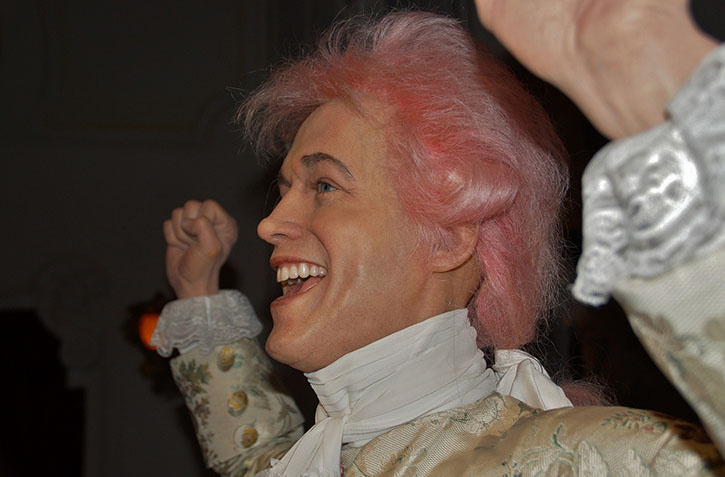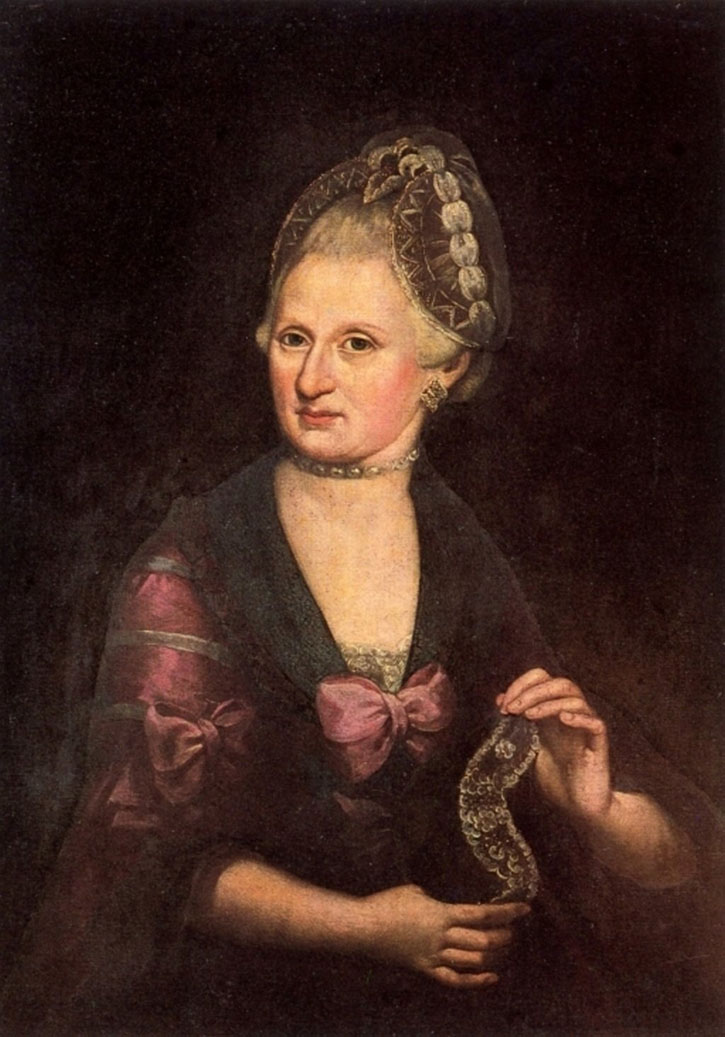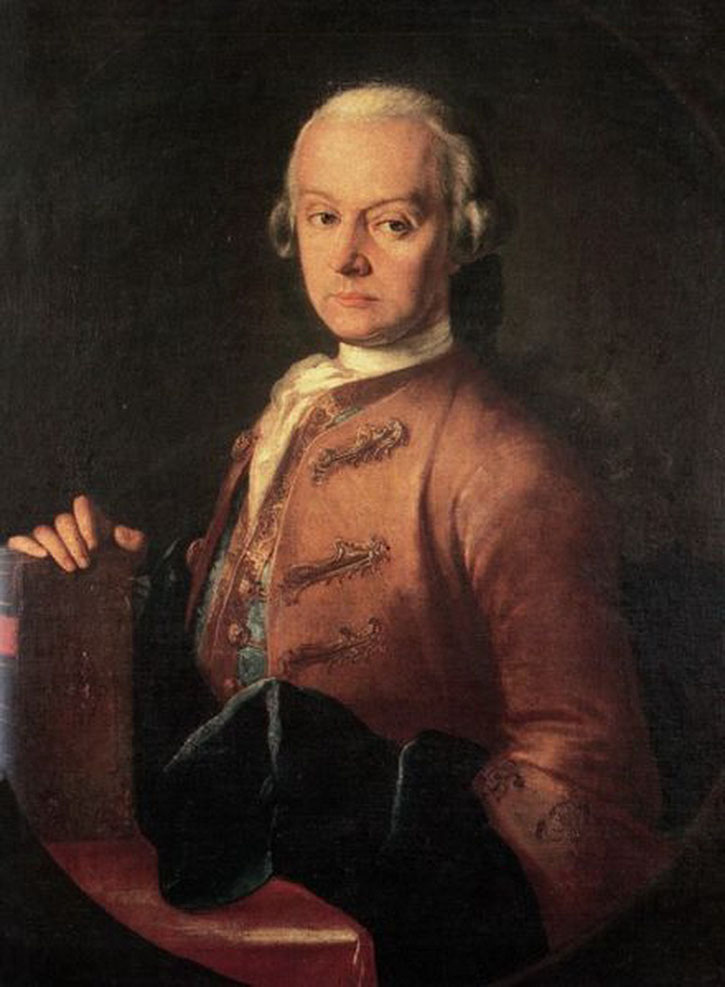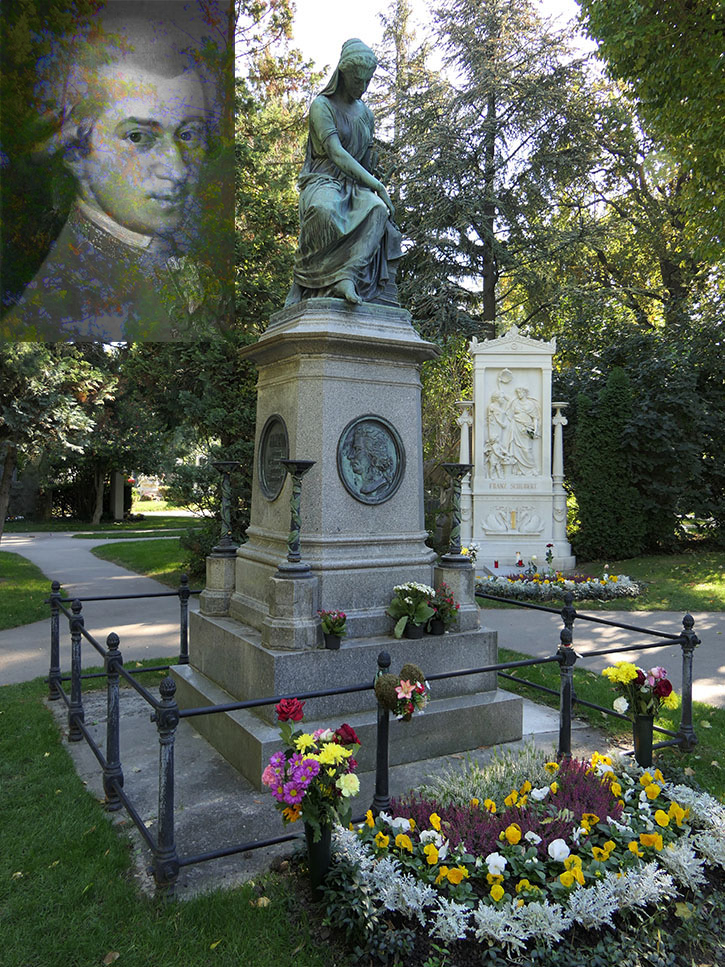In our second part about the life of the former child prodigy of classical music, we continue where we last stopped. At the return from Italy which he left as cavaliere di filarmonico. Mozart is only 14 years old ….
Objectively, Italy was a complete success. An only fourteen-year-old boy had managed to inspire the country of the opera with his skills and his music. He also got the order for his first opera! But Wolfgang and his father Leopold had been hoping to get a job for the young Mozart. That had not happened. Nevertheless, there can not be any talk of defeat, strictly.
As mentioned, Padre Giovanni Batista Martini had taught him counterpoint in Italy and he was accepted after an exam at the Accademia Filarmonica di Bologna. The aim of this musical academy was to unite the best musicians in Europe. They met regularly for music and for “conference”. Thus, the young Mozart had the chance to meet musicians like Giacomo Antonio Perti, Giovanni Paisiello or his dear friend Johann Christian Bach and to exchange ideas.
He also received further orders due to the successful opera Mitridate Re di Ponto.
Back in Salzburg, Mozart as concertmaster
Although Mozart had been unable to find a job in Italy, he was comforted by the following event: returning to Salzburg
he [finds] a letter from Count Firmian in Mayland, ordering in the name of Empress Maria Theresa, to write the great theatrical Serenata for the marriage of Archduke Ferdinand [of Austria].
(From: “Mozarts Leben” of Friedrich von Schlichtegroll, pp. 25/26)
Archduke Ferdinand is the son of Maria Theresa and is about to marry Princess Maria Ricciarda Beatrice of Modena. Said and done.
As a result, he and his father travel to Milan for a few months, and the Serenata teatrale “Ascanio in Alba” is played at the wedding. Mozart is now 15 years old, he allegedly writes the opera within three and a half weeks.
The hard times of a genius
1772 is not a great year. Especially when you consider how successful the trip to Italy was before that. Successful insofar that the Italians were inspired by the talent of the young Mozart. The hoped-for employment remained off. One of the reasons is, because he is a little man with a big ego, and nobody has waited in vain for that.
In 1772, Salzburg gets a new Prince-Archbishop, his name is Hieronymus Franz Joseph Count of Colloredo. Mozart is commissioned to write a play to his appointment, and so it is in October 1772, the premiere of the Serenate “Il Sogno Di Scipione” (in English: The Dream of Scipio). Hieronymus is said to be the last reigning Prince-Archbishop of the Principality of Salzburg. Until then, he governs economically, some would like to call it frugal. He gives Mozart his first real job as archbishop concertmaster in Salzburg, the merit is 150 guilders a year, which is very “economic” for the employer. So the Mozart family keep their eyes and ears open for further engagements. Wolfgang starts travelling with his father again. The good thing about composing is that you can work on the move, which was a rarity at the time without Wi-Fi.
They travel once more to Italy, the carnival in 1773 is approaching and Mozart still has an order for it. He is about to write an opera for the carnival. The premiere of the opera seria “Lucio Silla” will take place. During this trip, his “exsultate jubilate” is born. A firm commitment in Italy remains absent, repeatedly. They drive back to Salzburg, in order to return to Vienna soon after.
In the following years, trips to Vienna and Munich happen, which do not bring Mozart any jobs, but our genius can continue to educate and expand his horizons. For example, he discovers the pieces of Joseph Haydn and Antonio Salieri and writes many other compositions. One of them is his tenth opera, “la finta giardiniera” (“The Disguised Gardener”). This piece he writes for the Elector of Bavaria, Maximilian III. Joseph. At the age of 20 Mozart already looks back on a repertoire of about 300 compositions. Including ten operas. Despite his extraordinary talent and his multitude of partly very successful pieces, the career does not run in a steep curve. His only job was and still is the thrifty Archbishop. The poor payment and an allegedly unauthorized leave lead to the discord between the self-confident artist and his employer in 1777.
Here, a very lovely video of the Russian soprano Julia Lezhneva at the recording of Mozart´s “exsultate, jubilate”:
The wild years of young Mozart
Mozart is traveling again, this time with his mother at his side. It will again be a city trip with the constant goal of finding a good job. The father remains in the service of the archbishop in Salzburg. So that at least one in the family ensures a regular income.
Mozart starts with his mother first to Bavaria and Baden-Württemberg, through the cities of Munich, Augsburg and then to Mannheim. The two are doing well on this trip. His mother, however, returns from Mannheim first to Salzburg.
Mozart gives concerts on the journey and these are as usual crowned with success, but he receives neither a commitment nor orders. But a first emotional success may be set: in Mannheim, Wolfgang meets for the first time the Webers, a family of musicians, with her two daughters Aloysia and Constanze. Mozart falls in love with Aloysia and instead of – as agreed with the parents – travelling to Paris in 1778, he travels with the Weber family on concert tour to Den Haag and then back to Mannheim. He also supports the family both financially and musically. He writes whole arias for Aloysia, who performs as a soprano. She rejects his later marriage proposal.
Leopold Mozart is not enthusiastic about it. Therefore, he sends his wife to check. So mother Mozart returns to Mannheim to bring her son back on the “right musical” path.
Concerning his ability, his talent, Wolfgang Mozart is at his personal peak. With Paris as the largest marketplace for fine arts and Europe’s capital of luxury, the next step is near. Mother and son travel to France.
The lowest point in Paris
France is not charming at all to our genius. He tries to find a job here at the urging of his father. As great as his talent is, he receives only refusals from the French nobility. Without his childlike charm, even Marie Antoinette does not want to know him anymore. Accordingly, he and his mother live in a poor apartment without heating. Wolfgang has income only through music students, whom he teaches. He does not compose much. His most important composition in time is the “Paris Symphony”. And he can perform his ballet music with the almost ironic title “Les petits riens” (in English: the little things). After a few months of hardships in Paris, Anna Maria Mozart becomes very ill. For 14 days she is getting worse and worse, she fantasizes and finally loses her hearing. Her son watches over her bed at the guest house “Auberge des Quatre Fils Aymont”, where she dies on the third of July 1778. Her death has shaken Mozart very much, as evidenced by several letters to his father. He asks him to come back to Salzburg. But Mozart first has to overcome his inner darkness. First the rejection by Aloysia Weber, then the rejection of the French and finally the death of his beloved mother. This maturing process is also noticeable in his music.
Mozart is leaving France behind
There is disagreement about the exact reasons for his return from France The biographer Friedrich von Schlichtegroll says that Mozart is happy to return from Paris to Salzburg. Two other sources say that it is a rather reluctant return to which his father has urged him with a commitment in Salzburg. Since the new employer in Salzburg is the same archbishop, with whom there was already a rift, but at the same time Paris not being good to our genius, both will probably vote. He likes to turn his back on Paris, but is not looking forward to the engagement. In 1779 he starts the service. Tensions to his employer remain upright. Mozart does not like to accept orders. In addition, the archbishop cuts him in his travels to participate in profitable concerts. At least he is allowed to attend the successful premiere of his opera `Idomeneo´. This was on January 29, 1781 in Munich. Soon after, there is a second rift with the archbishop. The result is the famous literal “kick”, with which Count Arco, at that time an employee of the archbishop, brought Mozart to the door. In the year 1782 the canon “Leck mich im Arsch” (in English: lick my ass) by Mozart is dated. In the Köchelverzeichnis it has the number 382c. The temporal proximity to the incident with the archbishop is undeniable. The fact that Mozart is an expressive artist is further clarified hereby.
Here’s a nice interpretation of the canon on Dutch television:
Everything will be better in Vienna
Already around 1780 Mozart went to Vienna and there he is to stay until his death in 1791. First he comes to the capital, because he is ordered by the archbishop there. For the time being Mozart lives with family Weber, whom he knows from Mannheim. For him, Vienna is definitely also a chance for additional freelance commissions and concerts and to withdraw slowly from the archbishop. Which he will succeed in quite soon, as already described.
From now on, Mozart lives in Vienna, where he is also appreciated. First, he lives with the already well-known Weber family, who rent a room in Vienna. Aloysia’s sister Constanze lives there, too. And as life goes on, Mozart falls in love with Constanze. Father Leopold is not happy about his son’s decision, but he has to accept it. And the two will be happy! But even more. Professionally, Mozart settles in Vienna as a freelance composer and music teacher. And he gives concerts, of course. It could go better, but it starts. On 16 July 1782, his opera “Abduction from the Seraglio” is a great success, but he still receives only 100 guilders. Shortly thereafter, he marries Constanze, namely on 4 August 1782. Successful years begin for Mozart. The couple has a constantly busy house. Not only because of the two dogs and songbirds, there is also lively traffic with the music students, visitors come and go, Mozart composes a lot and earns good money. This lively house is today’s Mozarthaus Vienna, in Domgasse 5 in 1010 Vienna. During this time, a friendship with Joseph Haydn develops.
Mozart´s famous compositions and his father´s death
In the following years, some of his most famous works, such as 1786 “Le Nozze di Figaro” arise (in English: The Marriage of Figaro). First, the premiere in Vienna is unsuccessful, because the piece is very demanding and the occupation had too little time for rehearsals. It is probably a combination of the performance and the fact that it is a socially critical piece. He follows an invitation to perform the piece in Prague, where it will be a great success. As a result, he gets the contract for his work “Don Giovanni”. Financially, though, a lean phase follows again.
On May 28 1787, his father Leopold dies in Salzburg. Probably due to stomach cancer, the records report a “stomach hardening”. Since his wedding, Mozart has seen his father only twice, but he is shaken by his death.
In mourning and financial hardships, Wolfgang gets to work on Don Giovanni, which will be premiered on October 29, 1787. During this time, Ludwig van Beethoven comes from Bonn to Vienna at the age of sixteen. His declared aim as a gifted musician is to receive lessons from Mozart. Why this plan fails is not fully recorded. But two very unfavorable factors play a role. Mozart is currently in a bad phase of grief over his father and the pressure to finish Don Giovanni. Beethoven, on the other hand, can not stay in Vienna for very long because his mother becomes very ill and he returns to Bonn.
Aside from his grief for the father and the pressure of work, Mozart’s finances are starting to climb again on 7 December 1787, for Joseph II names him Imperial Chamber Musician. Annual salary 800 guilders. That was a good reward.
His next famous composition will be premiered in Vienna in 1790: the opera “così fan tutte” (in English: that’s what everyone does). In September 1791 Mozart has two premieres in a row. First the opera “La clemenza di Tito” (in English: “the mildness of Titus”) in Prague, then the well-known and popular “Magic Flute” in Vienna.
The clemenza di Tito was the work for the coronation of Joseph II the King of Bohemia.
Mozart and the lady(ies)
Mozart is not a handsome man. He is described as “[…] small, gaunt, pale and revealing nothing extraordinary in his physiognomy”. But he has a certain charm, on the one hand by his absolutely legitimate self-confidence and, on the other hand, his sense of rough humor. He allegedly has it from his mother. And he is a hedonist. All this makes him interesting for some women. Only his first love, Constanze’s sister Aloysia, wanted to know nothing more about him at the latest from the time of her own professional climax. One could say that Wolfgang was then content with the second choice, Constanze. But according to what is reported about the marriage of the two, it can be surmised that Constanze is the better sister for him. The two spend a very great marriage, revealed by surviving letters. Between 1783 and 1791 they get six children, but as with Mozart’s parents, only two live beyond their childhood. They are called Karl Thomas and Franz Xaver Wolfgang Mozart. There are some aspects to the success of the relationship between Constanze and Wolfgang Mozart. They share the passion for music. In addition, she comes to meet him in many ways, she is understanding and allows him as much undisturbed composing. It is also told that she can keep house. This can be doubted in light of the recurrent financial tragic moments she is confronted with. With good households in a freelance relationship one provides in periods of high yield for a buffer for lean times. That’s something Mozart can not do. What is certain is that Mozart deals very casually with money as long as it is there. This fits in with his hedonistic character. However, Constanze always has to suffer from an open leg – also called ulcus cruris. It is a deep ulcer in the lower leg. A very painful and at that time very expensive affair. Some of Mozart’s letters have survived, where he asks for money for these treatments but he never lives in really deep poverty. They always rent nice apartments and live well so far.
Mozart, his Death and the Requiem
The death of Mozart is on December 5, 1791. As shown above, the opera clemenza di Tito and the well-known Magic Flute are among his last great works. And of course the famous and legendary Requiem, which he had to leave incomplete. The mysterious circumstances that surround the commission for the Requiem and the fact that Mozart wrote it until his death, led to myth building. The statement of the composer that he knows that he is writing this work for himself adds to that. But one after the other.
At the beginning of the year 1791 an anonymous messenger arrives to Mozart with the order for a requiem. We already know that Mozart also gained some experience in church music. Finally he manages to get hold of the job as adjunct of the cathedral conductor at St. Stephan in Vienna. Unpaid but with the prospect of a proper job.
Half of the payment for the requiem is in advance. Mozart starts composing in spring. But two opera premieres just come in between this year. Not to speak of smaller works. His death in the same year prevented the completion completely.
What Mozart ultimately died of is not proven. Most conclusive to us is the implication that US scientists have encountered in recent research. This diagnosis is rheumatic fever, which leads to death at the time. Wolfgang had suffered from rheumatic attacks since childhood. An increase in this and increasing depression are recorded from this year. One even speaks of delusions and fears of death. The stress of the numerous compositions and the trips to the world premieres do the rest to weaken his body. The simultaneous contract work for the Requiem also makes Mozart express the conviction that he is writing this requiem for himself. In November of the year 1791 Mozart begins to suffer from high fever, increasing pain and swollen extremities. Shortly before, however, he is allowed to witness the successful premiere of his “Magic Flute”.
On the evening of December 5, 1791, he falls into a coma and dies at one o’clock in the night at Rauhensteingasse 8 in Vienna. Just a few months earlier, Constanze gave birth to his last child – Franz Xaver Wolfgang, one of the two sons who made it into adulthood. His wife is deeply shaken.
The Mozart-Requiem after his death
Until now, the requiem contains the following parts:
The following Kyrie and most of the Dies irae sequence (from Dies irae to Confutatis) were completed only in the vocals and the figured bass, in addition, various important orchestral parts (such as trombone solo in tuba mirum, more often voice of short violins) were sketched. The last movement of the sequence, the Lacrimosa, broke off after eight bars and remained incomplete. In the 1960s, a sketch for an Amen fugue was discovered, which apparently should have ended the sequence after the Lacrimosa. The following two movements of the Offertory, the Domine Jesu Christe and the Hostias, were again elaborated in the vocal parts and partly in the continuo. Sanctus with Benedictus, Agnus Dei and Communio were completely absent.
(translated from source: https://de.wikipedia.org/wiki/Requiem_(Mozart))
Of course, Constanze has a financial interest in completing this semi-paid commission. She sets out in search of a worthy subsequent composer. But hardly anyone will do justice to this task. Thanks to many small additional works, Franz Xaver Süßmayer, a former student and assistant of Mozart, succeeds in completing the Requiem. And so the Requiem is given to the hitherto anonymous messenger, who delivers it to his client. He later turns out to be the eccentric Count Franz von Walsegg. Since he himself seems to be a little talented composer, he had originally planned to let the requiem be written for the death of his wife and to declare it as his own composition. Hence the anonymous order. He also did that, according to a source. He had the Requiem premiered on December 14, 1793 in the Neukloster in Wiener Neustadt under his name. What he did not know, however, was that this Requiem was premiered on the 2nd of January of the same year in the Jahn’schen hall in Vienna …
Experience the Mozart Requiem in the Karlskirche Vienna
Click here for your ticket for the Requiem in Vienna
All questions concerning Mozart that have been answered
How was Mozart?
Mozart was a cliché genius. That from the saying “genius and madness are close to each other”. He was a very expressive person, they knew immediately what was going on in him, he had a lot of humor, like rough humor. And as is the case with extroverted jokers, they are often accompanied by depression. The same with Mozart, the child prodigy. Artistically, he grew up very quickly, which is why he did not grow up in real life, everyday life and always remained a child. He was hardly able to handle money or to bring structure into his life, for this he had first his parents and later his wife. But in music he is unbeaten until today. We do not think any other musician / composer is capable of gaining so much world fame and influence. Many of his best songs still give you goose bumps and are recognized around the world. Sometimes quite consciously, often unconsciously. But everyone knows them. And everybody knows him …
How many compositions are there of Mozart?
Already at the age of 20, Mozart looked back on more than 300 compositions, and in the end there were over 600 works he composed. The Köchelverzeichnis of 1862, the chronological-thematic catalog raisonné to Mozart’s compositions, sums up 626 works.
What are Mozart's most famous compositions?
Among Mozart’s compositions there are countless well-known melodies, which one often perceives as known, but does not know that they are from Mozart. Here are the seven best-known works listed chronologically:
- Idomeneo KV366 (1781) – Mozart’s own favorite piece, his first creative mission after 2 years of stagnation in Salzburg! The score of Idomeneo is one of his lushest and most unconventional pieces
- Marriage of Figaro KV492 (1786)
- The little Night Music KV525 (1787)
- Don Giovanni KV527 (1787)
- Così fan tutte KV588 (1790)
- The Magixc Flute KV620 (1791)
- Requiem KV626 (1791)
Which instrument did Mozart play?
Mozart played the piano and the violin. He showed his talent at the piano at the age of four, when his father Leopold actually taught his sister Nannerl. Shortly thereafter the piano lessons began. He gave his first concerts with his sister on the piano. At the age of seven he played the second voice almost perfectly on a gifted violin. Without previous lessons.
More detailed information in our first part Mozart – the Prodigy
Did Mozart know Beethoven?
Beethoven was fourteen years younger than Mozart. The 16-year-old Ludwig was musically talented and came to Vienna in 1787 to study with Mozart or Haydn. But Mozart had no time to receive him and Ludwig had to return to Bonn after 2 weeks because of his mother’s illness! They just missed each other …
Who was Mozart´s friend?
Wolfgang Amadeus Mozart lived in a very exciting time. Since he has come around a lot in the world, he has also met many people still known today. His most exciting friendships were:
- As a child to Marie Antoinette: She was the same age and when he gave a concert at the court of Versaille, they played together as children delightfully. Later, when he was no longer a prodigy, she did not want to know him anymore …
- As a teenager, he developed a close friendship with Johann Christian Bach, the son of Johann Sebastian Bach. He became a mentor to him.
- Joseph Haydn was a good friend of Mozart. This friendship developed from the year 1781. The 24 years older composer was a “father, leader and friend” to him. Mozart dedicated six string quartets to Haydn and both were members of the Masonic lodge “Zur wahren Eintracht”.
Have we made you want more with our article about the story of this wonderful exceptional musician? Then visit one of our classical concerts. Here, for example, you see “Le nozze di Figaro” by W.A. Mozart, played by the Vienna Residence Orchestra in the Palais Auersperg, the venue of the classical orchestra, which has been playing pieces by Mozart and Johann Strauss since 1990. A historical Vienna experience in original costumes, tickets for the concerts can be found on our homepage!




